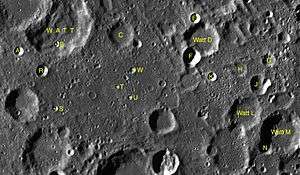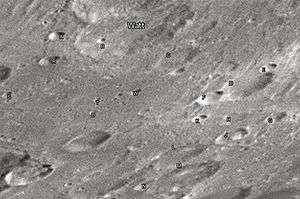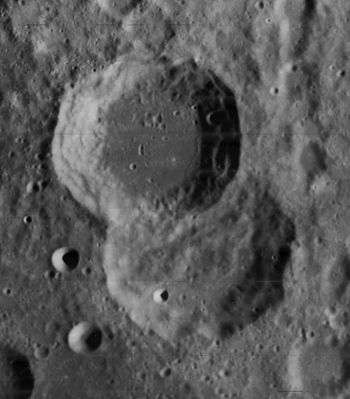Watt (crater)
|
Lunar Orbiter 4 image, with Steinheil at top and Watt below | |
| Coordinates | 49°30′S 48°36′E / 49.5°S 48.6°ECoordinates: 49°30′S 48°36′E / 49.5°S 48.6°E |
|---|---|
| Diameter | 66 km |
| Depth | Unknown |
| Colongitude | 313° at sunrise |
| Eponym | James Watt |
Watt is a lunar crater that is located in the southeastern part of the Moon. From Earth it appears oval in shape due to foreshortening.
The northwestern third of the crater rim has been completely overlain by the same-sized Steinheil, leaving much of the interior floor covered with the outer rampart of ejecta from the latter formation. The remainder of the rim of Watt is somewhat jagged in appearance, with an inward bulge along the southeast rim and a pair of small outward projections to the northeast. The rim is otherwise relatively sharply defined, with only a minor amount of wear.
Nearby craters of note include Biela to the south-southeast, Rosenberger to the southwest, and the walled plain Janssen to the northwest past Steinheil.
Satellite craters

By convention these features are identified on lunar maps by placing the letter on the side of the crater midpoint that is closest to Watt.

| Watt | Latitude | Longitude | Diameter |
|---|---|---|---|
| A | 50.3° S | 46.4° E | 10 km |
| B | 50.1° S | 48.0° E | 6 km |
| C | 50.0° S | 51.5° E | 24 km |
| D | 50.3° S | 55.2° E | 32 km |
| E | 49.7° S | 55.3° E | 10 km |
| F | 50.5° S | 54.3° E | 16 km |
| G | 50.9° S | 58.7° E | 13 km |
| H | 51.2° S | 57.2° E | 16 km |
| J | 51.6° S | 58.3° E | 18 km |
| K | 51.4° S | 55.9° E | 8 km |
| L | 52.6° S | 57.6° E | 32 km |
| M | 53.1° S | 59.9° E | 42 km |
| N | 53.6° S | 58.7° E | 11 km |
| R | 51.0° S | 47.5° E | 12 km |
| S | 52.2° S | 47.8° E | 6 km |
| T | 51.6° S | 51.0° E | 4 km |
| U | 52.0° S | 51.7° E | 5 km |
| W | 51.1° S | 51.9° E | 7 km |
References
- Andersson, L. E.; Whitaker, E. A. (1982). NASA Catalogue of Lunar Nomenclature. NASA RP-1097.
- Blue, Jennifer (July 25, 2007). "Gazetteer of Planetary Nomenclature". USGS. Retrieved 2007-08-05.
- Bussey, B.; Spudis, P. (2004). The Clementine Atlas of the Moon. New York: Cambridge University Press. ISBN 978-0-521-81528-4.
- Cocks, Elijah E.; Cocks, Josiah C. (1995). Who's Who on the Moon: A Biographical Dictionary of Lunar Nomenclature. Tudor Publishers. ISBN 978-0-936389-27-1.
- McDowell, Jonathan (July 15, 2007). "Lunar Nomenclature". Jonathan's Space Report. Retrieved 2007-10-24.
- Menzel, D. H.; Minnaert, M.; Levin, B.; Dollfus, A.; Bell, B. (1971). "Report on Lunar Nomenclature by the Working Group of Commission 17 of the IAU". Space Science Reviews. 12 (2): 136–186. Bibcode:1971SSRv...12..136M. doi:10.1007/BF00171763.
- Moore, Patrick (2001). On the Moon. Sterling Publishing Co. ISBN 978-0-304-35469-6.
- Price, Fred W. (1988). The Moon Observer's Handbook. Cambridge University Press. ISBN 978-0-521-33500-3.
- Rükl, Antonín (1990). Atlas of the Moon. Kalmbach Books. ISBN 978-0-913135-17-4.
- Webb, Rev. T. W. (1962). Celestial Objects for Common Telescopes (6th revised ed.). Dover. ISBN 978-0-486-20917-3.
- Whitaker, Ewen A. (1999). Mapping and Naming the Moon. Cambridge University Press. ISBN 978-0-521-62248-6.
- Wlasuk, Peter T. (2000). Observing the Moon. Springer. ISBN 978-1-85233-193-1.
| Wikimedia Commons has media related to Watt (crater). |
